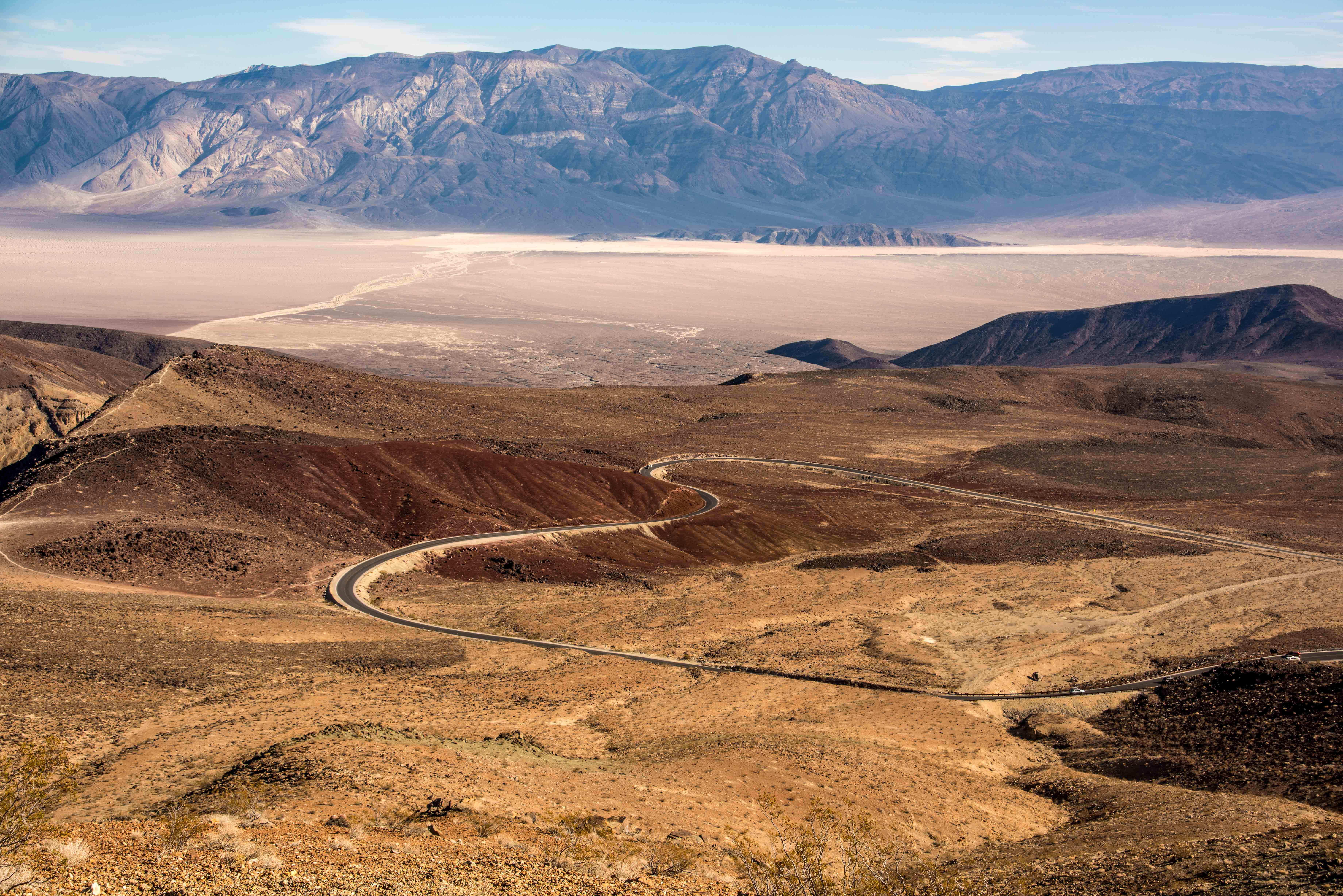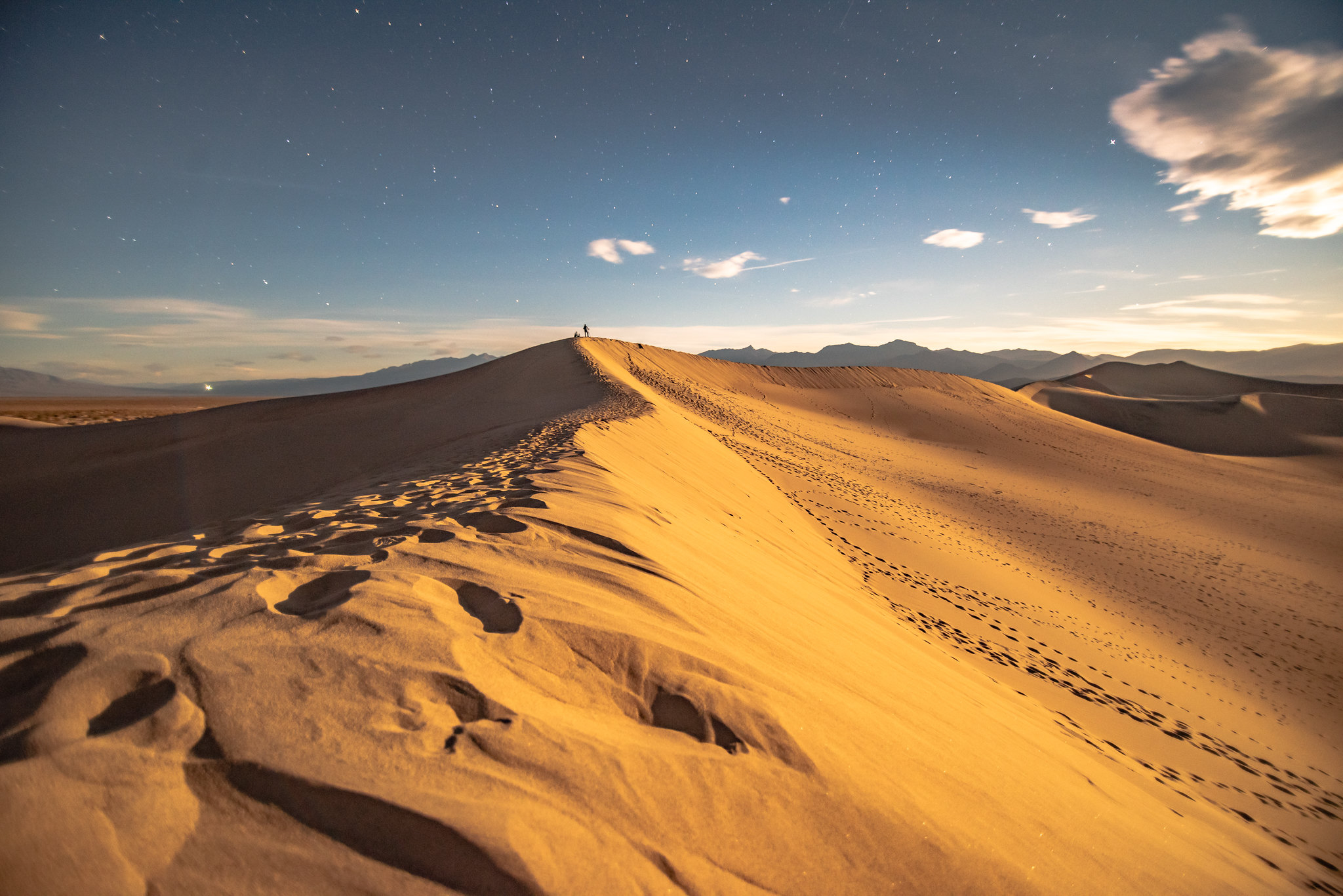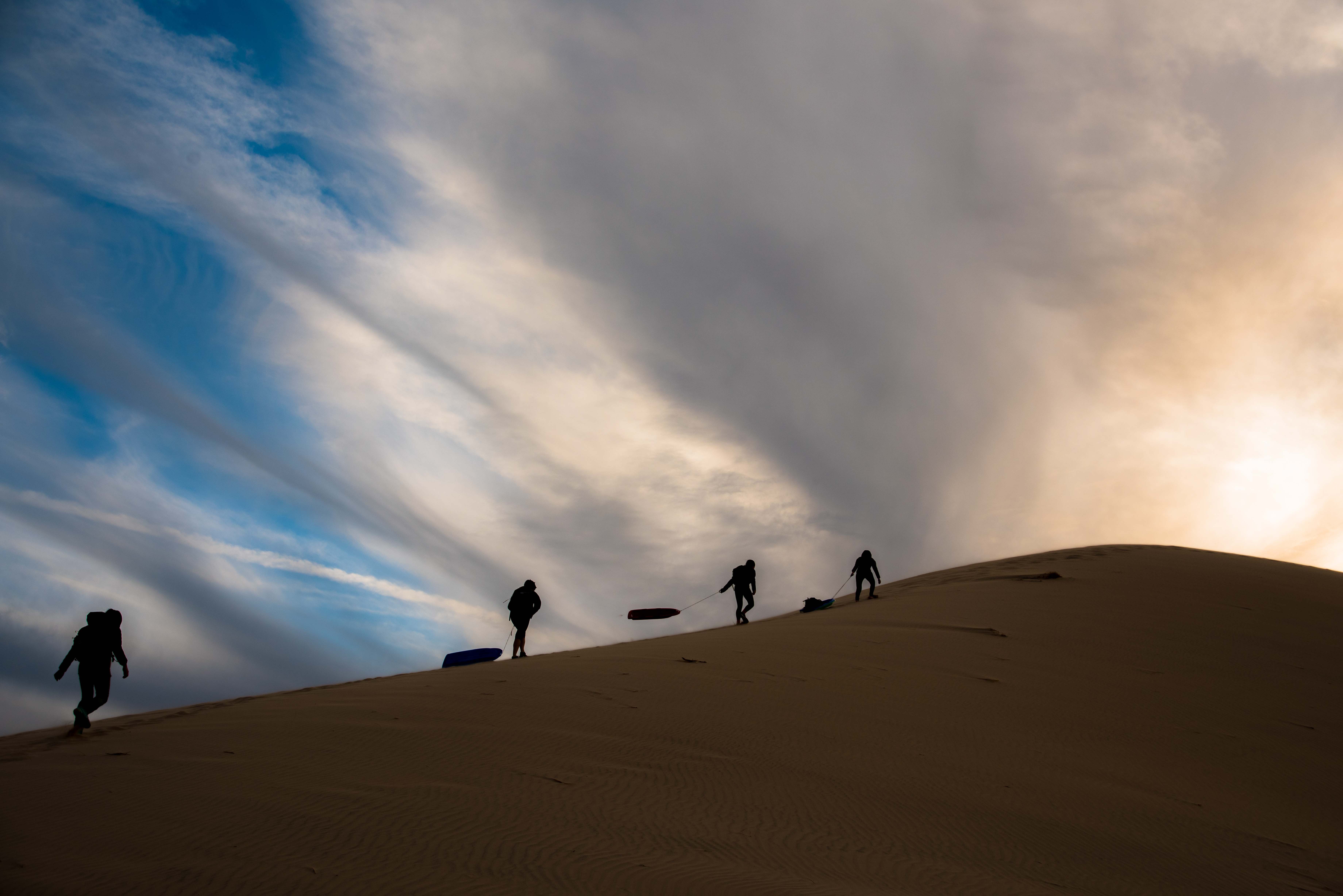
From the hustle and bustle of San Francisco, all the way to the Grand Canyon National park, the round trip covers a whopping 1900-mile adventure. Tackle Southern California’s desert landscapes of the Lone Pine and the Death Valley National Park, and pass over the border to Las Vegas and through to the Grand Canyon National park. While returning, explore the tallest sand dunes and the spectacular hole-in-the wall at the Mojave National Preserve. Whether you choose to explore a complete journey or a small section, the desert road trip of the Southwestern America will truly be a memorable experience like no other journey. Here, you will experience the breathtaking national parks, empty desertscapes, lowest and highest points in the US, and the twinkling desert skies. Hop on the car and let’s start our adventure.
Table of contents
- San Francisco to San Luis Reservoir
- San Luis Reservoir to Red Rock Canyon
- Red Rock Canyon to Lone Pine
- Lone Pine to Death Valley
- Death Valley to Las Vegas
- Las Vegas to Grand Canyon
- Grand Canyon to Mohave National Preserve

SAN FRANCISCO TO SAN LUIS RESERVOIR
120 miles
Windy Reservoir
Two hours south of San Francisco, driving through the rolling grassy hills, our first stop on the way to the Grand Canyon is San Luis Reservoir. Just off the highway 152, the view of the reservoir lake is spectacular and therapeutic. It’s a perfect pit stop to stretch your legs and enjoy the San Luis Reservoir State recreation area known for camping, hiking, and fishing. Overlooking the San Luis Reservoir, explore the Romero visitor Center that hosts educational displays about the California water system and conservation efforts. Hike down to experience the reservoir up close with sweeping views of the reservoir and the windmills at a distance.

SAN LUIS RESERVOIR TO RED ROCK CANYON
250 miles
The California’s underrated state park
After countless miles of driving on interstate I-5 through the central valley of California, you will reach Red Rock Canyon State Park just off the route 14 north of Mojave, CA. Red rock canyon offers spectacular views of mountain buttes, beautiful rock formations, massive cliffs, and vibrant colours and texture of the rocky landscape. The Red Rock Canyon State Park was underwater in a massive lake some 10 million years ago, which gives the unique texture and colour to the rock formation. The red canyon’s colour comes from varying content of iron oxide giving unique blend of shades of tone and contrast.

Stretch your legs by hiking the Hagan Nature Trail, which is marked by a stone path that leads to the most exquisite rock formation. Also explore the Red Cliffs Trail that boasts cliffs that shoot up to the ground ~300 ft high like a massive cathedral. Experience the Joshua trees under a vibrant sunset, and head towards Lone Pine for hotel accomodation before it gets too dark.

RED ROCK CANYON TO LONE PINE
100 miles
The view of the mighty Mount Whitney
After an easy 90-minute drive, you’ll reach the town of Lone Pine in Owen Valley, which is an incredible gateway to the nearby Alabama hills to the west, Mt. Whitney, Diaz lake, and the Mobius Arch.
Whether you are a hiker, climber, biker, photographer, camper, or just a travel enthusiast, Alabama hills is a must see destination in Southern California. Head to Alabama hills before the sunrise, to experience the colorful desertscapes on one side and the standing high snowy Sierra mountains on the other. Sunrise at Alabama hills is breathtaking, with beautiful colours of clouds covering the Sierra mountain range and Inyo mountains. Experience the mighty mount Whitney that looms above the wilderness with a strange silence of eternity.



Explore the out of this world martian-like terrain that is composed of amazing rock formation and arches, located along the foothills of the Sierra Nevada Mountain range. Mobius Arch is famous with photographers, as the arch acts like a natural frame to the Sierra Mountain Range backdrop. During the night, Camp for free and soak in the star-studded sky on a clear night at one of the darkest places in the US.
For its scenic location, Alabama hills has a movie history, the area is frequently filmed for western movies, with more than 400 films in the last 100 years including the recent films including Iron Man and Django Unchained. Head to the movie museum in Lone Pine that chronicles all of the movies that were made here.
LONE PINE TO DEATH VALLEY
120 miles
Exhilarating Desert Landscapes
It’s time to hit the road again, head 120 miles east to the Death Valley National Park, which is home to the singing sand dunes, salt flats, craters, ghost towns, colourful badlands, wild flowers and the mysterious sailing stones. Death Valley is a park of extremes, with being the hottest, driest, and the lowest national park in the U.S. While exploring Death Valley, you will feel a sense of adventure where you are all alone by yourself surrounded by empty long stretches of desolate landscapes. You will be lost in the barren landscape. This unique landscape creates a sensory experience that breaks the monotony of our everyday lives. The desolation draws you in: it’s calm; it’s solitary, and the never ending roads with constantly changing horizons; and the desert skies ablaze with twinkling stars.


Whether you choose to hike the highest point (>5575 ft ) at Dante’s view and the lowest point (-282 ft) at Badwater salt basin, or simply explore the off road trails on a 4×4, Death Valley is an adventurer’s dream coming true.
During the sunrise, explore the Zabriskie Point, to see the first light with many photographers lined up to capture picture perfect postcards of the badlands. During the day, explore the colourful Artists Palette, and the rugged Devils Golf Course while heading towards the Badwater basin salt flats. At Badwater, hike an easy in-and-out from boardwalk to salt flats at the lowest point in the continental U.S. During sunset, do not miss the Mesquite flat sand dunes for its spectacular display of light and shadow that creates a contrasting landscape like never seen before. Stay late to soak in the milky way or the moonrise over the desert sand dunes with star-studded sky to yourself.


Slideshow pictures of Mesquite salt flat dunes during sunset


If time is on your side, explore the Ubehebe crater or the mysterious sailing stone on the race track playa, where the rocks have been found to be moved on the desert ground with no gravitational cause. This strange phenomenon has baffled scientists and tourists alike.
Despite its name, Death Valley actually has quite a bit of life in its landscape. If you are lucky, you may view and experience the thriving wildlife including the coyote, kit fox, desert bighorn and the panamint rattlesnakes.

DEATH VALLEY TO LAS VEGAS
150 miles
Neon Paradise
The next leg of the great desert road trip sprawls another 150 miles east to the sparkling city of Las Vegas. Las Vegas is no ordinary city, but total escapist fantasy. Vegas is home to the bustling nightlife, gambling, dining, and entertainment. Head to Fremont Street to experience cocktail lounges, piano bars, and casinos. Then, explore the Vegas strip, be ready to be transported in the era of mythical cities of ancient Rome and Egypt. Experience the incredible dancing fountains at the Bellagio. If the neon paradise is not enough, head just 50 miles towards the Valley of Fire state park to experience the red sandstone rock formations, petrified trees, and petroglyphs that date back millions of years. As time descends to night, unlike the eerily quiet skies of Death Valley, in sharp contrast, savour the incredible cluster of Neon lights under the desert sky at Las Vegas.


LAS VEGAS TO GRAND CANYON
280 miles
Experiencing one of the seventh natural wonder
Buckle up for a 300-mile drive east from Vegas to Grand Canyon, which is Arizona’s only world heritage site designated by UNESCO. The Grand Canyon is a true wonder of nature. The Canyon is a mighty 200 miles long and 11 miles wide at the South Rim. At the bottom you will find the gorgeous Colorado river at a depth of 1 mile from any of the view points. Seeing the sunrise or sunset at the Grand Canyon South Rim is a phenomenal once in a lifetime experience that should never be missed. Spend the day walking along the rim or drive on the Desert view road toward the Watchtower to stop and enjoy many viewpoints of the Grand Canyon.



Although the Grand Canyon is the main attraction, don’t let this distract from all the small attractions including the wildlife, and the fauna. If you are an avid hiker, then take the South Kaibab Trail and return on the Bright Angel Trail – to experience Canyon from the top and the bottom. Have a word with the Grand Canyon visitors center before you take this adventurous trek, as it’s not a trek suggested for the unprepared.
Do not miss the sunset at the Desert view for its stunning display of silhouettes and changing colours. When the sun is low on the horizon, the landscape lights up with different shades of red, orange, and pink. Stay late and beat the crowds to enjoy the night solitude and on a full moon day, experience a once in a lifetime moonlight display of Canyons and star studded skies.
GRAND CANYON TO MOJAVE NATIONAL PRESERVE
350 miles
Desert wonderland
In the first leg of the return journey, head 80 miles south through the Kaibab National Forest to Flagstaff, Arizona. Flagstaff is a perfect getaway for rejuvenating your body and soul from all the travel so far. With so many choices of hotels at Flagstaff, and its closeness to the Grand Canyon, it’s an ideal destination for rest, recuperation and repeating your adventure. If time is not a factor, do not miss the ancient Native American ruins at Wupatki National monument or the stunning views at Walnut Canyon National monuments.

Buckle up for another 270 miles west to the Hole in the Wall situated in Mojave National Preserve. Hike clockwise along the Hole in the wall rings trail. The trail has ring bolts that serve as a hand support giving access to the steep and narrow section of the trail loop. Overlooking the visitor center, there is a unique view of the pocketed rock walls. This phenomenon is a result of volcanic eruption, where the trapped gas on the molten lava dissipates and creates a hole during the solidification process. Hear the crying sound of the wind that blows around/through the rocky holes.
Just 30 miles southwest of the Hole in the Wall, discover the 650 ft tall fascinating, beautiful, and enigmatic sand mountain of Kelso Dunes in the middle of nowhere. Hiking to the summit of sand dunes is the most popular activity in Mojave National Preserve. Although popular, it’s a gruelling hike to the summit due to loose sand and high elevation gain. You will encounter people with sand boards hiking up to later slide down on their return. Do not miss to hear the booming sounds that are specific to Kelso dunes, an eerie rumbling sound that you can feel to the bones.
But once you are at the top, the sweeping views will make you feel like you are in the Sahara Desert. Do not miss the sunset at the top of the dunes, as the low horizon sunlight will create magic on the dunes, where no words or the pictures can express the beautiful sight. It has to be experienced in person. The shapes and patterns of sand will dance to the tune of light and shadows. Seated on the summit and taking in the amazing views all by yourself will truly be worthy given its tough hike.



For the night, you can find accommodation at Barstow that is just 90 min drive from Kelso dunes. In the morning, complete your final return journey of 530 miles to San Francisco.
This ends our guide to the spectacular journey through beautiful national parks, desertscapes, and the natural wonders of the earth. As Anthony Bourdain quotes
“Travel isn’t always pretty. It isn’t always comfortable. Sometimes it hurts, it even breaks your heart. But that’s okay. The journey changes you; it should change you. It leaves marks on your memory, on your consciousness, on your heart, and on your body. You take something with you. Hopefully, you leave something good behind.”
-Anthony Bourdain
I hope I had left something good behind.
Thanks for your support. I will appreciate your valuable comments.





Isn’t it incredible? ❤️ funny to hear you speak of areas I know and roads I drive on lol
And it’s sooo breathtaking to see what nature painted ❤️
What a trip – very beautiful ❤️🙌
LikeLiked by 1 person
Thank you again. It was indeed a memorable road trip through some iconic landscapes of USA. Glad you know and driven through these areas.
LikeLiked by 1 person
Sounds like it was an amazing road trip. I love how drastically different the landscape changes in some of these places. Your pictures are gorgeous.
LikeLiked by 2 people
This trip was done during one of the thanksgiving break. Each and every scenes of nature was memorable to last details. Thanks for your wonderful comment.
LikeLiked by 1 person
Good to hear from you, Vignesh. I’ve always loved your photography!
LikeLiked by 2 people
Thank you so much for your kind comment. Being consistent in posting is difficult, but that’s exactly what I am trying.
LikeLiked by 2 people
Great road trip! Wonderful photography! Well shared 🙂
LikeLiked by 1 person
Thank you for your wonderful comment.
LikeLike
Welcome 🤗 I am happy to know that you became happy 😘
LikeLike
Great information! Thank you for sharing.
LikeLiked by 1 person
I like this road trip as a way of bypassing the populated coastal regions of California. The oppressive heat would however definitely have to be considered. The east side looking toward the Sierras seems of high interest as well to me.
LikeLiked by 1 person
Yes I agree with you. Its more remote than the coast. I did this during Thanksgiving. So it was on the cooler side.
LikeLike
Great trip, though I can do without Vegas.
LikeLiked by 1 person
Thank you! Totally agree with you on that. Best was to camp at Death Valley instead of Vegas.
LikeLiked by 1 person
Wow… Suburb photography!!! Loved it!! Each one of them is a classic!!! Thanks for sharing Vignesh!
LikeLike
Thank you Jyothi 🙂
LikeLiked by 1 person